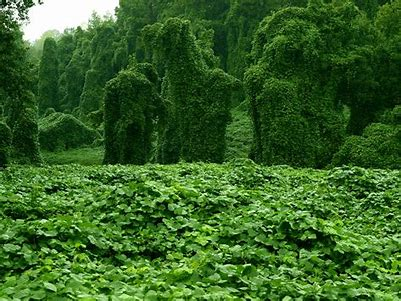
It is everywhere and becoming even more everywhere by the minute. You cannot ignore it and it is going to be tough to get rid of. Like many examples of well-intentioned but ill-conceived biological introductions outside of their native ranges, the kudzu plant is quickly covering any vertical structure throughout southeastern United States as far north as Pennsylvania and westward to Illinois. The Soil Conservation Service oftentimes receives the dubious credit for promoting the planting of kudzu circa 1930. The government paid farmers, I said paid farmers, to plant kudzu as an answer to control soil erosion. And by golly, it seems to work just fine for that purpose. Kudzu is native to Asia and a member of the pea family. Like other members of the pea family, kudzu is a nitrogen-fixing plant that works in symbiosis with bacteria to increase soil nitrogen content.
If there is a silver lining to this dark kudzu cloud, because there are many dark clouds associated with this plant, it is that kudzu is not only fine and beneficial for human consumption but it has historical medicinal properties. Nutritionally, kudzu is high in protein, high in fiber, much like its cousin soybean curd, aka tofu. The leaves, shoots, flowers, and roots of kudzu are consumed with spring to early summer harvest yielding the best results. Kudzu leaves can be prepared and eaten as traditional southern greens are, the roots used as a thickener like cornstarch, and the flowers made into a jelly that has flavor reminiscent of grape jelly. Bees that feed predominantly on kudzu blooms produce a honey that some say tastes like bubblegum. Medicinally, kudzu extracts lay claim to treat menopausal symptoms, cluster headaches, stomach distress, and even said to prevent binge alcohol drinking. Various herbal supplement forms are available in health food stores and Asian markets.
Be sure to do your part to control this invasion that has the capability to spread as much as one foot per day during the summer. So, pass the plate and have another helping of kudzu. I do believe the plant is gaining on us.
Kudzu Lemonade (Yields about about 1/2 gallon)
Ingredients
- 5 cups freshly picked, washed kudzu blossoms – 7-1/2 cups water, divided
- 3/4 cup sugar – 1/2 cup lemon juice
Directions
1. Submerge the blossoms in a glass container with 7 cups of cool water. Soak overnight. After soak, strain and discard the blossoms. Re-strain the gray-colored kudzu water through a fine cloth or coffee filter.
2. In a saucepan over low heat, dissolve the sugar in remaining 1/2 cup of water. Set aside to cool. Add lemon juice. Stir the lemon mixture into the kudzu water. Serve over ice.
